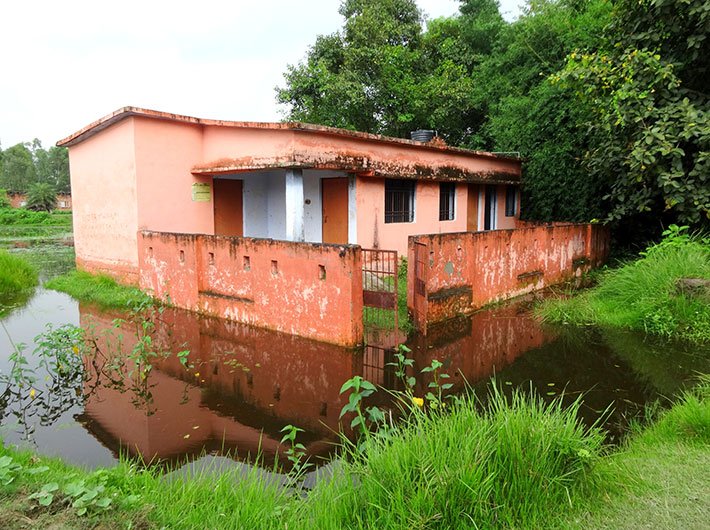Health sub-centres in rural Uttar Pradesh are serving no purpose despite huge investment on their buildings
All is not well with healthcare delivery at the grassroots. Exploring the government healthcare system in the rural belts of Sitapur district in Uttar Pradesh during my five-month long field work, some worrying facts surfaced about the state of health sub-centres (SCs). These centres are peripheral units of the government health services available in villages. At present, with the exception of a few SC buildings in the district (seven out of 468), none are being used for any purpose – neither to conduct deliveries (where there is a dedicated labour room in each building), nor to serve as a permanent residence for the auxiliary nurse midwife (ANM) who stays at the centre and provide health services.
A sub-centre in Uttar Pradesh is manned only by an ANM and it ideally serves a population of 5,000. As per the Indian Public Health Standards (IPHS) guidelines, a sub-centre must be located within the village for providing easy access to people and safety of the ANM.
Until a decade ago, majority of SCs in the state were operating in rented buildings (often in one to two rooms). Not only did SCs running in these rented houses suffer from problems like insufficient space, lack of toilets and washing facilities, but they also had to be periodically relocated from one building to another, as it was very hard to find a room available for Rs 250 (money allocated by the government as monthly rental) per month. Later, the government decided that each SC in the state should have its own new building for proper functioning. Thus, the proportion of SCs running in their own government buildings has increased from 40.3 percent to 96.1 percent in just four years (2007–11).
However, by simply looking at the official statistics one should not presume that all is well on the ground. Many buildings are permanently locked, lying unused ever since they were constructed. Even the newer buildings appear dilapidated, often devoid of essential amenities such as hand pumps, electricity, electric wiring, functional toilets and overhead water tanks.
Contrary to the IPHS recommendations, most SC buildings are located on the village outskirts. They are usually surrounded by agricultural fields, mango groves, ponds, heaps of cow dung or household waste and communal cattle sheds. The reason why these buildings are constructed away from the main settlement is that the government does not buy any land for it. In fact, it relies on the sarpanch of the village to allocate free-of-cost land. As free lands are seldom available in the village, communal lands (also called public utility lands) on the outskirts are frequently allocated for this purpose.
The inappropriate location of the buildings serves no purpose and also raises security concerns for ANMs who are supposed to stay there 24x7. It is way too risky to spend the night in these isolated buildings, especially for a woman. The four-foot-high boundary wall of the SC building further exacerbates this insecurity. Anti-social elements do not hesitate to jump over the wall to enter the premises. Incidents like defecation, theft, playing poker, drinking, etc. in the sub-centres are frequently cited. SCs are often looted, vandalised and misused. During my field visits, I observed many instances where the SCs’ main gates were missing, walls were crumbling, locks were broken, switchboards were smashed, snatched wires were dangling, boundaries were demolished, bricks were stolen, and equipment was crushed. Stools, chairs, torn bags, used syringes, etc. were scattered on the floor. A number of SC premises were used as cattle sheds or storage by the villagers.
As the only staff member posted at the SC, an ANM cannot take care of the building at all times, as she has to visit 10 to 30 villages every month as part of her work. Since existing buildings cannot be physically relocated to a better site, the only way to ensure effective use of these buildings is to increase the number of health workers at the sub-centres from one to four, as per IPHS recommendations. This can instil a sense of security among fellow resident health workers and they subsequently think of staying in these otherwise unused/underused/misused buildings. However, this, too, seems impossible, as existing SCs in the state are designed with only two small rooms, a bathroom and a kitchen, which constitute the entire ‘residence’ for the ANM. In other words, it is not possible to accommodate more than one worker per SC in the existing buildings. Thus, there is very little hope that these buildings will ever be used for their intended purposes.
Furthermore, the construction of buildings is supposed to be supervised and monitored by panchayat raj institutions (PRIs) and ANMs, but they – as outsiders (not locals) – don’t feel empowered to raise their voices against any corruption or transgressions that may occur. The head of the village council (pradhan), a local, often dominates the entire process, and the quality of the building largely depends on his attitudes and interests towards the project. Most SC buildings are constructed using low-grade mortar and the cheapest available poor quality brick, known as ‘peela’. Several SCs have been constructed in low-lying areas such as ponds, ditches and puddles. The floors of such buildings have caved in as the land beneath is not filled and levelled properly. All new buildings feature windows with glass panes. The material that holds the glass in place is often sub-standard and very weak, so much so that even light winds cause the glass to fall on the floor and shatter. Therefore, it is not surprising that most of the window frames in SCs are devoid of glass panes.
Moreover, staircases to the roof and wall racks inside the rooms were found missing in these buildings. Given the poor supply of electricity in the villages (where electricity is available only six hours a day) and the hot climate in northern India, people (read health workers) often prefer to sleep under the open sky rather than under a roof in summers. Unfortunately, there are no staircases that lead to the terrace. Even the new buildings suffer from water leakages and have also developed dangerous cracks in the walls.
Despite having clear policies on health sub-centre buildings, the government is still erecting useless structures at inappropriate locations. An approximate of Rs 9 lakh is spent on construction of one SC building on the outskirts. One must question why a huge amount of money is being wasted when SCs can be run in rented rooms within the village area. A simple calculation tells us that when considering the current rent of Rs 250 per month (per room), an amount of Rs 9 lakh can be used to pay for the rent of an SC for the next 300 years. Even if the rent increases up to Rs 500 or Rs 1,000 per room per month, the same amount of money can be used for at least 150 years or 75 years respectively – well beyond the average official lifespan of a newly built government building in the state. Hence, the money currently being spent on these buildings is a complete waste of public funds.
Also, the effective delivery of healthcare at the grassroots level can only be ensured if an ANM permanently stays in the headquarter village. However, this is not possible until we provide her with a safe and secure residence and workplace. The government should change its policy on the free acquisition of communal land in any village located in the outskirts; rather, it should favour the act of purchasing land within the main settlement area to construct an SC. If the government wishes to increase the number of health workers, as per IPHS recommendations, then it must think about altering the design of its buildings to accommodate three to four families – not three to four individuals. The government also needs to decentralise monitoring activities by involving ANMs and PRIs in the land allocation and building construction processes; this would not only assist in checking for corruption and improving the quality of SC buildings, but it would also contribute to fostering a sense of community ownership for the health facility. n
Singh is a PhD candidate at the School of Health Sciences and Social Work, University of Portsmouth (UK)
(The article appears in November 16-30, 2016 edition of Governance Now)



